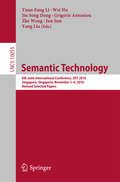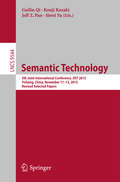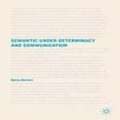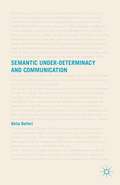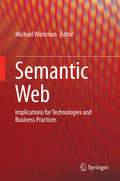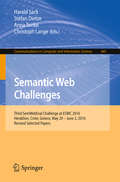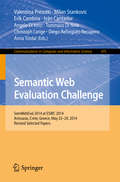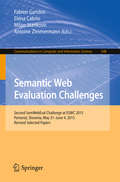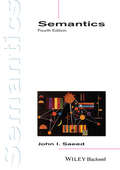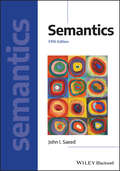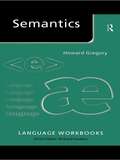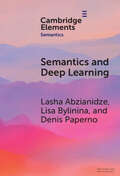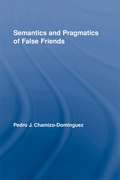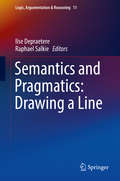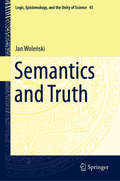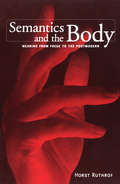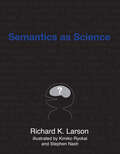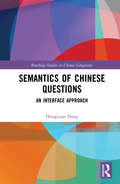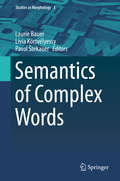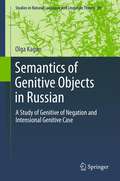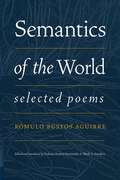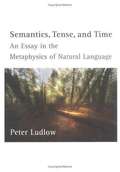- Table View
- List View
Semantic Technology
by Grigoris Antoniou Yang Liu Zhe Wang Yuan-Fang Li Wei Hu Jin Song Dong Jun SunThis book constitutes the thoroughly refereed proceedings of the 6th Joint International Semantic Technology Conference, JIST 2016, held in Singapore, Singapore, in November 2016. The main topics of JIST 2016 include among others ontology and reasoning; linked data; knowledge graph. The JIST 2016 conference consists of two keynotes, a main technical track, including (full and short papers) from the research and the in-use tracks, a Poster and Demo session, a workshop and two tutorials. The 16 full and 8 short papers presented were carefully reviewed and selected from 34 submissions. The papers cover the following topics: ontology and data management; linked data; information retrieval and knowledge discovery; RDF and query; knowledge graph; application of semantic technologies.
Semantic Technology
by Guilin Qi Kouji Kozaki Jeff Z. Pan Siwei YuThisbook constitutes the thoroughly refereed proceedings of the 5th JointInternational Semantic Technology Conference, JIST 2015, held in Yichang,China, in November 2015. The theme of the JIST 2015 conference was "Big Data andSocial Media". The JIST 2015 conference consisted of main technical tracksincluding 2 keynotes, 2 invited talks, a regular technical paper track (fulland short papers), an in-use track, a poster and demo session, workshop, andtutorial. The 14 full and 8 short papers in this volume were carefullyreviewed and selected from 43 submissions. The paper cover the followingtopics: ontology and reasoning, linked data, learning and discovery, RDF andquery, knowledge graph, knowledge integration, query and recommendation, andapplications of semantic technologies.
Semantic Under-Determinacy and Communication
by Delia BelleriCombining a fresh, previously unexplored view of the subject with a detailed overview of the past and ongoing philosophical discussion on the matter, this book investigates the phenomenon of semantic under-determinacy by seeking an answer to the questions of how it can be explained, and how communication is possible despite it.
Semantic Under-determinacy and Communication
by D. BelleriCombining a fresh, previously unexplored view of the subject with a detailed overview of the past and ongoing philosophical discussion on the matter, this book investigates the phenomenon of semantic under-determinacy by seeking an answer to the questions of how it can be explained, and how communication is possible despite it.
Semantic Web
by Michael WorkmanThis book examines recent developments in semantic systems that can respond to situations and environments and events. The contributors to this book cover how to design, implement and utilize disruptive technologies. The editor discusses the two fundamental sets of disruptive technologies: the development of semantic technologies including description logics, ontologies and agent frameworks; and the development of semantic information rendering and graphical forms of displays of high-density time-sensitive data to improve situational awareness. Beyond practical illustrations of emerging technologies, the editor proposes to utilize an incremental development method called knowledge scaffolding -a proven educational psychology technique for learning a subject matter thoroughly. The goal of this book is to help readers learn about managing information resources, from the ground up and reinforcing the learning as they read on.
Semantic Web Challenges
by Christoph Lange Harald Sack Anna Tordai Stefan DietzeThis book constitutes the thoroughly refereed post conference proceedings of the third edition of the Semantic Web Evaluation Challenge, SemWebEval 2016, co-located with the 13th European Semantic Web conference, held in Heraklion, Crete, Greece, in May/June 2016. This book includes the descriptions of all methods and tools that competed at SemWebEval 2016, together with a detailed description of the tasks, evaluation procedures and datasets. The contributions are grouped in the areas: Open Knowledge Extraction (OKE 2016); Semantic Sentiment Analysis (SSA 2016); Question Answering over Linked Data (QALD 6); Top-K Shortest Path in Large Typed RDF Graphs Datasets; Semantic Publishing (SemPub2016).
Semantic Web Evaluation Challenge
by Christoph Lange Erik Cambria Valentina Presutti Milan Stankovic Iván Cantador Angelo Di Iorio Tommaso Di Noia Diego Reforgiato Recupero Anna TordaiThis book constitutes the thoroughly refereed post conference proceedings of the first edition of the Semantic Web Evaluation Challenge, SemWebEval 2014, co-located with the 11th Extended Semantic Web conference, held in Anissaras, Crete, Greece, in May 2014. This book includes the descriptions of all methods and tools that competed at SemWebEval 2014, together with a detailed description of the tasks, evaluation procedures and datasets. The contributions are grouped in three areas: semantic publishing (sempub), concept-level sentiment analysis (ssa), and linked-data enabled recommender systems (recsys).
Semantic Web Evaluation Challenges
by Milan Stankovic Fabien Gandon Elena Cabrio Antoine ZimmermannThisbook constitutes the thoroughly refereed post conference proceedings of thesecond edition of the Semantic Web Evaluation Challenge, SemWebEval 2015,co-located with the 12th European Semantic Web conference, held in Portorož,Slovenia, in May/June 2015. This book includes thedescriptions of all methods and tools that competed at SemWebEval 2015,together with a detailed description of the tasks, evaluation procedures anddatasets. The contributions are grouped in the areas: open knowledge extractionchallenge (OKE 2015); semantic publishing challenge (SemPub 2015);schema-agnostic queries over large-schema databases challenge (SAQ 2015);concept-level sentiment analysis challenge (CLSA 2015).
Semantics
by James R. Hurford Brendan Heasley Michael B. SmithThis practical coursebook introduces all the basics of semantics in a simple, step-by-step fashion. Each unit includes short sections of explanation with examples, followed by stimulating practice exercises to complete in the book. Feedback and comment sections follow each exercise to enable students to monitor their progress. No previous background in semantics is assumed, as students begin by discovering the value and fascination of the subject and then move through all key topics in the field, including sense and reference, simple logic, word meaning and interpersonal meaning. New study guides and exercises have been added to the end of each unit to help reinforce and test learning. A completely new unit on non-literal language and metaphor, plus updates throughout the text significantly expand the scope of the original edition to bring it up-to-date with modern teaching of semantics for introductory courses in linguistics as well as intermediate students.
Semantics
by John I. SaeedThe third edition of this popular textbook provides an engaging and accessible introduction to semantics for students new to the field. Explores the basic concepts and methods of the field and discusses some of the most important contemporary lines of researchContains new solutions to chapter exercises in order to familiarize the student with the practice of semantic descriptionCompletely revised and updated to reflect recent theoretical developmentsIncludes new sections on classifiers and noun classes, as well as conceptual integration
Semantics (Introducing Linguistics #25)
by John I. SaeedRevised and updated to reflect recent theoretical developments in the field, Semantics, 4th Edition, presents an engaging and accessible introduction to the study of meaning in language for students new to the field of semantics. Covers all of the basic concepts and methods of the field of semantics, as well as some of the most important contemporary lines of research Features a series of new exercises, along with their solutions, that are arranged by level of difficulty Addresses componential theory, formal semantics, and cognitive semantics, the three main current theoretical approaches to semantics Includes revisions and updates that reflect the most recent theoretical developments
Semantics (Introducing Linguistics #25)
by John I. SaeedThe latest edition of the bestselling introduction to the field of linguistic semantics, updated throughout and featuring a wholly new chapter on inferential pragmatics Semantics, Fifth Edition, is a comprehensive and well-balanced introduction to the study of the communication of meaning in language. Assuming no previous background in semantics and limited familiarity with formal linguistics, this student-friendly textbook describes the concepts, theory, and study of semantics in an accessible and clear style. Concise chapters describe the role of semantics within contemporary linguistics, cover key topics in the analysis of word and sentence meaning, and review major semantic theories such as componential theory, formal semantics, and cognitive semantics. The updated fifth edition incorporates recent theoretical developments and important research in linguistic semantics, featuring an entirely new chapter examining the overlap between inferential pragmatics and Relevance Theory, truth-conditional meaning, and other traditional areas of semantics. Revised and expanded sections discuss the continuing growth and consolidation of cognitive semantics, various contextual features of language, conceptualization and categorization, and construal and perspective. This edition includes new exercises with solutions, up-to-date references to relevant literature, and additional examples with data from a wide range of different languages. Covers basic concepts and methods as well as key theoretical models, current lines of research, and important writers Explains general concepts in semantics before gradually moving to more advanced topics in semantic description and theoretical approaches Highlights the relation between cross-linguistic variation and language universals Provides students with the background necessary to understand more advanced and specialized primary semantics literature Includes a glossary of technical terms and numerous exercises arranged by level of difficulty Highlights the relationship between semantics and cross-linguistic variation, language universals, and pragmaticsWith detailed examples from a wide range of contexts and a wealth of practical exercises, Semantics, Fifth Edition, remains the perfect textbook for undergraduate students of linguistics, English language, applied linguistics, modern languages, and computer sciences.
Semantics (Language Workbooks)
by Howard GregorySemantics is an accessible and practical introduction to formal semantics, the study of linguistic meaning, for students new to the subject. Semantics:* shows how meanings are built up and interrelated* presupposes very little prior knowledge of grammar or linguistic terminology * includes a glossary of technical terms* provides a progression of exercises with answers given at the back * backs up the activities with short, clear explanations* includes an appendix on sets and functions.
Semantics and Communication
by John C. Condon Jr.New to the third edition is an exploration of creativity and problem solving in terms of semantics.
Semantics and Deep Learning (Elements in Semantics)
by Lasha Abzianidze Lisa Bylinina Denis PapernoThis Element covers the interaction of two research areas: linguistic semantics and deep learning. It focuses on three phenomena central to natural language interpretation: reasoning and inference; compositionality; extralinguistic grounding. Representation of these phenomena in recent neural models is discussed, along with the quality of these representations and ways to evaluate them (datasets, tests, measures). The Element closes with suggestions on possible deeper interactions between theoretical semantics and language technology based on deep learning models.
Semantics and Pragmatics of False Friends (Routledge Studies in Linguistics)
by Pedro J. Chamizo-DomínguezThis book approaches the topic of false friends from a theoretical perspective, arguing that false friends carry out a positive role as a cognitive device, mainly in literature and jokes, and suggesting some pragmatic strategies in order to restore the original sense of a text/utterance when a given translator (or a foreign speaker) falls victim to false friends. This theoretical account is successively verified by appealing to texts from the fields of literature, science, philosophy, journalism, and everyday speech.
Semantics and Pragmatics: Drawing a Line
by Ilse Depraetere Raphael SalkieThis book explores new territory at the interface between semantics and pragmatics, reassessing a number of linguistic phenomena in the light of recent advances in pragmatic theory and presenting stimulating insights by experts in linguistics and philosophy. The authors begin by reassessing the definition of four theoretical concepts: saturation, free pragmatic enrichment, completion and expansion. They go on to confront (sub)disciplines that have addressed similar issues but that have not necessarily been in close contact, and then turn to questions related to reported speech, modality, indirect requests and prosody. Chapters investigate lexical pragmatics and (cognitive) lexical semantics and other interactions involving experimental pragmatics, construction grammar, clinical linguistics, and the distinction between mental and linguistic content. The authors bridge the gap between different disciplines, subdisciplines and methodologies, supporting cross-fertilization of ideas and indicating the empirical studies that are needed to test current theoretical concepts and push the theory further. Readers will find overviews of the ways in which concepts are defined, empirical data with which they are illustrated and explorations of the theoretical frameworks in which concepts are couched. This exciting exchange of ideas has its origins in the editors' workshop series on the theme 'The semantics/pragmatics interface: linguistic, logical and philosophical perspectives', held at the University of Lille 3 in 2012-13. Scholars of linguistics, logic and philosophy and those interested in the research benefits of crossing disciplines will find this work both accessible and thought-provoking, especially those with an interest in pragmatic theory or semantics.
Semantics and Truth (Logic, Epistemology, and the Unity of Science #45)
by Jan WoleńskiThe book provides a historical (with an outline of the history of the concept of truth from antiquity to our time) and systematic exposition of the semantic theory of truth formulated by Alfred Tarski in the 1930s. This theory became famous very soon and inspired logicians and philosophers. It has two different, but interconnected aspects: formal-logical and philosophical. The book deals with both, but it is intended mostly as a philosophical monograph. It explains Tarski’s motivation and presents discussions about his ideas (pro and contra) as well as points out various applications of the semantic theory of truth to philosophical problems (truth-criteria, realism and anti-realism, future contingents or the concept of correspondence between language and reality).
Semantics and the Body: Meaning from Frege to the Postmodern
by Horst RuthrofIn traditional semantics, the human body tends to be ignored in the process of constructing meaning. Horst Ruthrof argues, by contrast, that the body is an integral part of this hermeneutic activity. Strictly language-based theories, and theories which conflate formal and natural languages, run into problems when they describe how we communicate in cultural settings. Semantics and the Body proposes that language is no more than a symbolic grid which does not signify at all unless it is brought to life by non-linguistic signs.Ruthrof reviews and analyses various 'orthodox' theories of meaning, from the views of Gottlob Frege at the beginning of the twentieth century to those of theorists in the postmodern period, then offers an alternative approach of his own. His theory features 'corporeal semantics,' and holds that meaning has ultimately to do with the body and that the meaning of linguistic expressions is indeterminate without the aid of visual, tactile, olfactory, and other bodily signs. This approach also remedies what Ruthrof sees also as a loss of interpretive will in the postmodern era.Pedagogy in many fields could be enriched by a systemic integration of non-verbal semiosis into the linguistically dominated syllabus. Those involved in discourse analysis, literature, art criticism, film theory, pedagogy, and philosophy will find the implications of Ruthrof's study considerable.
Semantics as Science
by Richard K. LarsonAn introductory linguistics textbook that takes a novel approach: studying linguistic semantics as an exercise in scientific theory construction.This introductory linguistics text takes a novel approach, one that offers educational value to both linguistics majors and nonmajors. Aiming to help students not only grasp the fundamentals of the subject but also engage with broad intellectual issues and develop general intellectual skills, Semantics as Science studies linguistic semantics as an exercise in scientific theory construction. Semantics offers an excellent medium through which to acquaint students with the notion of a formal, axiomatic system—that is, a system that derives results from a precisely articulated set of assumptions according to a precisely articulated set of rules. The book develops semantic theory through the device of axiomatic T-theories, first proposed by Alfred Tarski more than eighty years ago, introducing technical elaboration only when required. It adopts Japanese as its core object of study, allowing students to explore and investigate the real empirical issues arising in the context of non-English structures, a non-English lexicon and non-English meanings. The book is structured as a laboratory science text that poses specific empirical questions, with 25 short units, each of which can be covered in one class session. The layout is engagingly visual, designed to help students understand and retain the material, with lively illustrations, examples, and quotations from famous scholars.
Semantics of Chinese Questions: An Interface Approach (Routledge Studies in Chinese Linguistics)
by Hongyuan DongSemantics of Chinese Questions is the first major study of Chinese questions, especially wh-questions, within the framework of Alternative Semantics. It takes an interface approach to study the syntax, semantics, and phonology of questions and proposes a phonological scope-marking strategy in Chinese questions, based upon experimental data. It also incorporates historical linguistic data regarding the grammaticalization of sentence-final particles such as –ne and –ma to study the formal diachronic semantics of questions. Primarily suitable for scholars in the field of Chinese linguistics, this book makes new theoretical contributions to the study of questions.
Semantics of Complex Words
by Lívia Körtvélyessy Pavol Štekauer Laurie BauerThis volume offers a valuable overview of recent research into the semantic aspects of complex words through different theoretical frameworks. Contributions by experts in the field, both morphologists and psycholinguists, identify crucial areas of research, present alternative and complementary approaches to their examination from the current level of knowledge, and indicate perspectives of research into the semantics of complex words by raising important questions that need to be investigated in order to get a more comprehensive picture of the field. Recent decades have seen both extensive and intensive development of various theories of word-formation, however, the semantic aspects of complex words have, with a few notable exceptions, been rather neglected. This volume fills that gap by offering articles written by leading experts in the field from various theoretical backgrounds.
Semantics of Genitive Objects in Russian
by Olga KaganThe genitive/accusative opposition in Slavic languages is a decades-old linguistic conundrum. Shedding new light on this perplexing object-case alternation in Russian, this volume analyzes two variants of genitive objects that alternate with accusative complements--the genitive of negation and the intensional genitive. The author contends that these variants are manifestations of the same phenomenon, and thus require an integrated analysis. Further, that the choice of case is sensitive to factors that fuse semantics and pragmatics, and that the genitive case is assigned to objects denoting properties at the same time as they lack commitment to existence. Kagan's subtle analysis accounts for the complex relations between case-marking and other properties, such as definiteness, specificity, number and aspect. It also reveals a correlation between the genitive case and the subjunctive mood, and relates her overarching subject matter to other instances of differential object-marking.
Semantics of the World: Selected Poems (Afro-Latin American Writers in Translation)
by Rómulo Bustos AguirreA poet of both the body and spirit, the work of Rómulo Bustos Aguirre often explores the nature of existence at the turn of the twenty-first century—humankind&’s relationship to itself and the universe, the meaning or purpose, if any, of human existence, and the daunting task of discerning that meaning. Critics have described his poetry as highly refined lyricism, metaphysical, existential, and at times erotic. Semantics of the World introduces the English-speaking world to the exciting work of Rómulo Bustos Aguirre, one of Colombia&’s most celebrated living writers.This selection of extraordinary poems, edited and translated by Nohora Arrieta Fernández and Mark A. Sanders, presents Bustos Aguirre&’s works in Spanish alongside their English translations and features the critical apparatus necessary for making Bustos Aguirre&’s poetry more accessible to students, scholars, and the general reading public. The volume offers the perfect introduction to Rómulo Bustos Aguirre and his poetry for critical and popular audiences throughout the Anglosphere.
Semantics, Tense, and Time: An Essay in the Metaphysics of Natural Language
by Peter LudlowOne of the central goals of this book is to illustrate how one can study metaphysical questions from a linguistic/semantical perspective. The specific issue that the author has chosen to investigate is the well-entrenched dispute between A-theorists and B-theorists about the nature of time.
